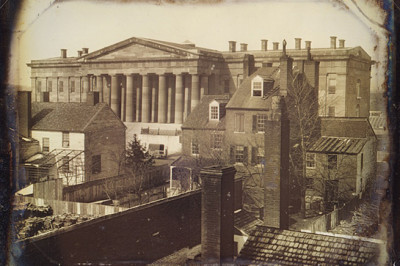



With the presidential election just around the corner, this Pick-5 is inspired by your Constitutional right to vote. A big challenge is finding the best way to collect and count those votes. Who can forget the controversies of the 2000 election regarding ballots? Whether it’s a punch card or a touch screen, inventors have worked hard to get your vote… counted that is. History shows that we may yet still have improvements to make, but here are some of the inventions that shaped our voting process over the decades.
Note: This article is part of an ongoing series detailing some of the Inventors Eye staff’s favorite patents. For each article, the writer selects their five favorite patents under a given theme. This list is from Office of Innovation Development Program Planner and Analyst Sean Wilkerson.
Electronic Vote-Recorder
U.S. Patent no. 90,646
Thomas A. Edison’s first patent, issued June 1, 1869, for an “improvement in electrographic vote-recorder” may be one we could all use today. This device allowed legislators to vote by flipping switches: - one end would signify a "yes" vote, and the other a "no" vote - and deliver the information via electric current to a main recorder, which would dispense the votes into two columns. After the legislators voted, a clerk would feed a piece of chemically-treated paper, which would then be used to "print" the votes out for everyone to see. The plan was to speed up the voting process by putting an end to filibustering and coercing others to change their votes. It seems to have been “vetoed” on the spot and despite advancements in technology, legislative votes are still often done by voice to this day.
Voting Apparatus
U.S. Patent no. 248,130
This “voting apparatus” patent was issued to Anthony. C. Beranek of Chicago on October 11, 1881. In his patent, Beranek claimed “by means of this device all fraud is prevented and ballot-box stuffing impossible,” but this design still needed to answer the question of is the hand quicker than the eye? It seems that one could easily press a button twice, if fast enough. This was the first official voting machine patented for use in an American general election.
Ballot Holder
U.S. Patent no. 440,547
Taking accountability, security, and technology to the next step, this patent was issued to Kennedy Dougan of Missoula, Montana on November 11, 1890. Dougan’s “ballot holder” had a roll of paper that allowed a voter to make a perforation for a candidate. The roll would then be advanced to a clean ballot for the next voter. Simple, efficient, and a paper trail. It seems effective as long as you don’t misplace the paper.
Voting Machine
U.S. Patent no. 628,905
This may be my favorite. Issued on July 11, 1899 to to Alfred J. Gillespie of Rochester, N.Y., for a “voting machine.” Gillespie already had a patent on a previous voting apparatus. This particular machine pulled a curtain around the voter in preparation for the votes to be recorded.
Method and Apparatus for Voting
U.S. Patent no. 5,585,612
Nearly 150 years after Edison’s effort to simplify the voting process, technology reached another electoral milestone—maybe not with speed but with accessibility. Patent no. 5,585,612 was issued to Roland J. Harp Jr. of Winchester, Kentucky, on December 17, 1996, for his “method and apparatus for voting. Using an audio presentation, Harp’s machine enabled illiterate and sight-impaired individuals to select the candidate of their choice in private without need for assistance by a third party.
Now get out there and punch, press, or mark your ballot to be counted!
The USPTO gives you useful information and non-legal advice in the areas of patents and trademarks. The patent and trademark statutes and regulations should be consulted before attempting to apply for a patent or register a trademark. These laws and the application process can be complicated. If you have intellectual property that could be patented or registered as a trademark, the use of an attorney or agent who is qualified to represent you in the USPTO is advised.